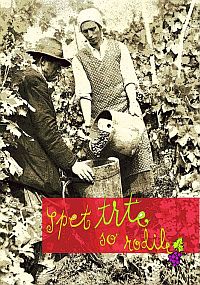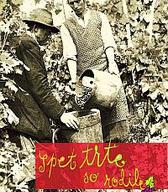Anew the vines have fruited: the Culture of Wine in Slovenia
20th November 2008 – June 2009
The grapevine (Vitis vinifera) is one of the oldest cultivated plants, which has been grown for its grapes and wine in Slovene lands since Roman times. From it has grown the museum story entitled The vintage, friends, is over: the culture of wine in Slovenia.
 The grapevine, its products, and the role of viticulture and wine in relation to different material, social and spiritual aspects of culture have been written about (and to a considerable extent still are) from an ethnological, historical, archaeological, agricultural, enological, medical and other points of view. To encompass all this knowledge and present it in a musuem format seems like a demanding task, but also a challenge, particularly in light of the recognition that the culture of wine has a very significant role in Slovenia. The main aims of the exhibition are to depict the presence of wine as a theme in different aspects of Slovene culture, to strengthen awareness of the three winegrowing regions and their natural inheritance, to pass on the key facts about the annual winegrowing cycle and to emphasise our conviction that wine is a precious drink that calls for cultured consumption.
The grapevine, its products, and the role of viticulture and wine in relation to different material, social and spiritual aspects of culture have been written about (and to a considerable extent still are) from an ethnological, historical, archaeological, agricultural, enological, medical and other points of view. To encompass all this knowledge and present it in a musuem format seems like a demanding task, but also a challenge, particularly in light of the recognition that the culture of wine has a very significant role in Slovenia. The main aims of the exhibition are to depict the presence of wine as a theme in different aspects of Slovene culture, to strengthen awareness of the three winegrowing regions and their natural inheritance, to pass on the key facts about the annual winegrowing cycle and to emphasise our conviction that wine is a precious drink that calls for cultured consumption.
"The culture of a nation, population or society changes: it was different in the past from what it is now and what it will be in the future. If culture consists of customs, habits and way of life, it is influenced by the environment in which we live. This is why wine-drinking habits of Slovenes in the winegrowing areas of the Primorje region are different from those in Alpine areas without grapevines and in pre-Alpine winegrowing localities, and different again in places where the pre-Alpine hills drop down to the plains along the rivers Drava, Sava and Krka." Thus writes the leading expert on Slovene wine and the culture of wine Dr. Dušan Terčelj in the monograph The Culture of Wine in Slovenia (2007). The knowledge and wisdom contained in this book, the fruit of the author's lifetime of research into wine, was a valuable source of inspiration when creating the exhibition.
That wine is part of Slovenia’s identity and that it symbolically unites Slovenes in their national anthem, adapted from the poem Zdravljica (A Toast), is mentioned by Dr. Aleš Gačnik in the introduction to Terčelj's book. And this is where we found the idea for both the title and the theoretical framework of the exhibition. Prešeren's poem from 1844 begins "The vintage, friends, is over, / And here sweet wine makes, once again, / Sad eyes and hearts recover" and is a paeon to the role of the grapevine and vine in inspiring human dignity. It goes on not only to talk about the idea of a united Slovene nation, notably in the 7th stanza, which since 1990 has also formed the words of the Slovene national anthem.
Thus the exhibition is not just a narrative about wine, but strives to present its role and importance within the culture and ways of life in Slovene lands. The visitor is introduced to the exhibition by the eloquent photographs of the Haloze Hills and their people by Stojan Kerbler. Just before the entrance are three signs for osmice or pušelšanke, which is where domestic wine was sold for home consumption; these also symbolise the three Slovene winegrowing regions – Primorska, Podravje and Posavje. In the introduction, where Dr. Janez Bogataj confirms that wine is ubiquitous in Slovenia, we explore the role of wine in everyday life, in religious ceremonies, in artistic creation, in matters of health and in connection with the erotic and the political. That a Slovene film is unimaginable without wine is confirmed by the film extracts that are also on view. A gallery depicting the role of wine in Slovene culture is complemented by a timeline showing important wine-related facts and individuals who have had an important influence on wine culture, from the 6th century right up to the present.
The annual winegrowing cycle is presented in the section Vine and wine through the year. As Andrej Dular notes, viniculture is one of the most demanding and difficult agricultural domains, calling for special knowledge, constant education, continuous and consistent work in the vineyard, and constant care for the vine and its products. All this is directed at a single goal – to produce as much wine as possible of the highest possible quality. The tasks involved, which we show through museum objects from Slovene collections as well as contemporary items, are divided between work in the vineyard and work in the cellar. The individual seasons are symbolically marked by particular saints. The emphases of this section include the dangers that threaten the vine, a projection of images of wine cellars by Dr. Vito Hazler and 'mountain rights', the collection of rules and regulations applying to highland landowners and winegrowers from the 13th century onwards.
There are three good things in the world: the three Slovene winegrowing regions says Dr. Janez Bogataj, and in the exhibition section under this title are images of these three, together with their characteristic varieties. An important element of the culture of wine are drinking vessels, which have received much attention from curators of Slovene museums. Dr. Verena Vidrih Perko from the Gorenjska Museum in Kranj has included them in a project involving nine museums called Cheers! Drinking vessels from Slovene museums down the centuries, which is an integral part of the current exhibition on wine.
The next section deals with the inn as the main social space connected to the drinking of wine and it is underlined by a pictorial collage of celebrations of events from the cycle of life that are always accompanied by wine.
We would like to emphasise that wine is a vibrant cultural element within contemporary life. Evidence for this claim are phenomena that began to appear particularly in the nineteen-nineties. These include associations that pay hommage to wine in ritual fashion, such as the Order of St. Fortunat, the Association of Slovene Kinghts of Wine and the European Order of the Knights of Wine; another is the Wine Queen of Slovenia, joined by an increasing number of local wine queens; a third is wine routes, which have a long tradition of linking together wine sellers, but are today more a part of the tourist trade.
One of the recurring themes of the exhibition is the people connected with the production and consumption of wine, without whom there would be no culture of wine. They are shown in particular through the caricatures of Aljana Primožič. And finally – let wine bring pleasure and enjoyment, but let moderation prevail over excess, which is all too evident in Slovenia. Cheers!


